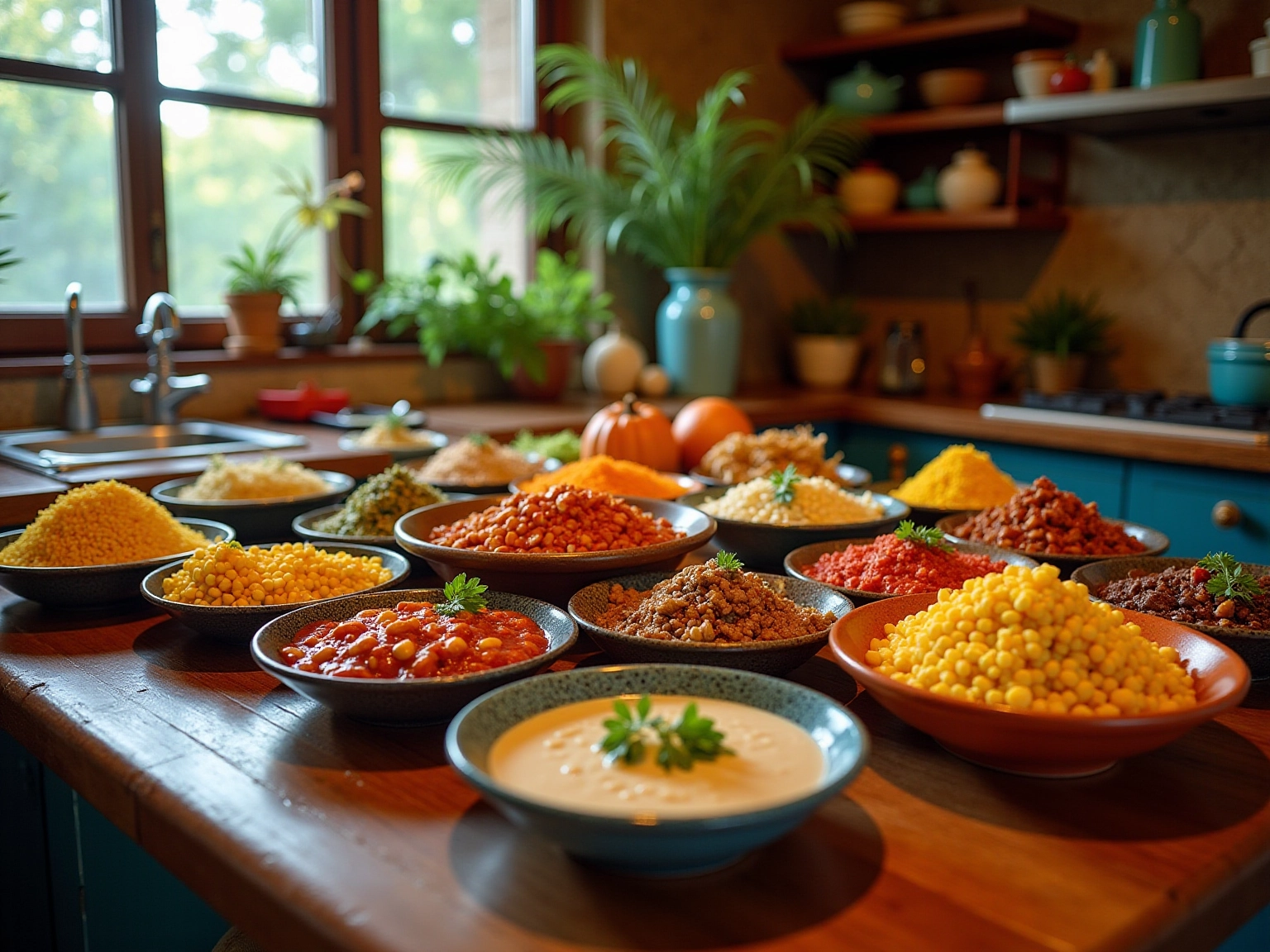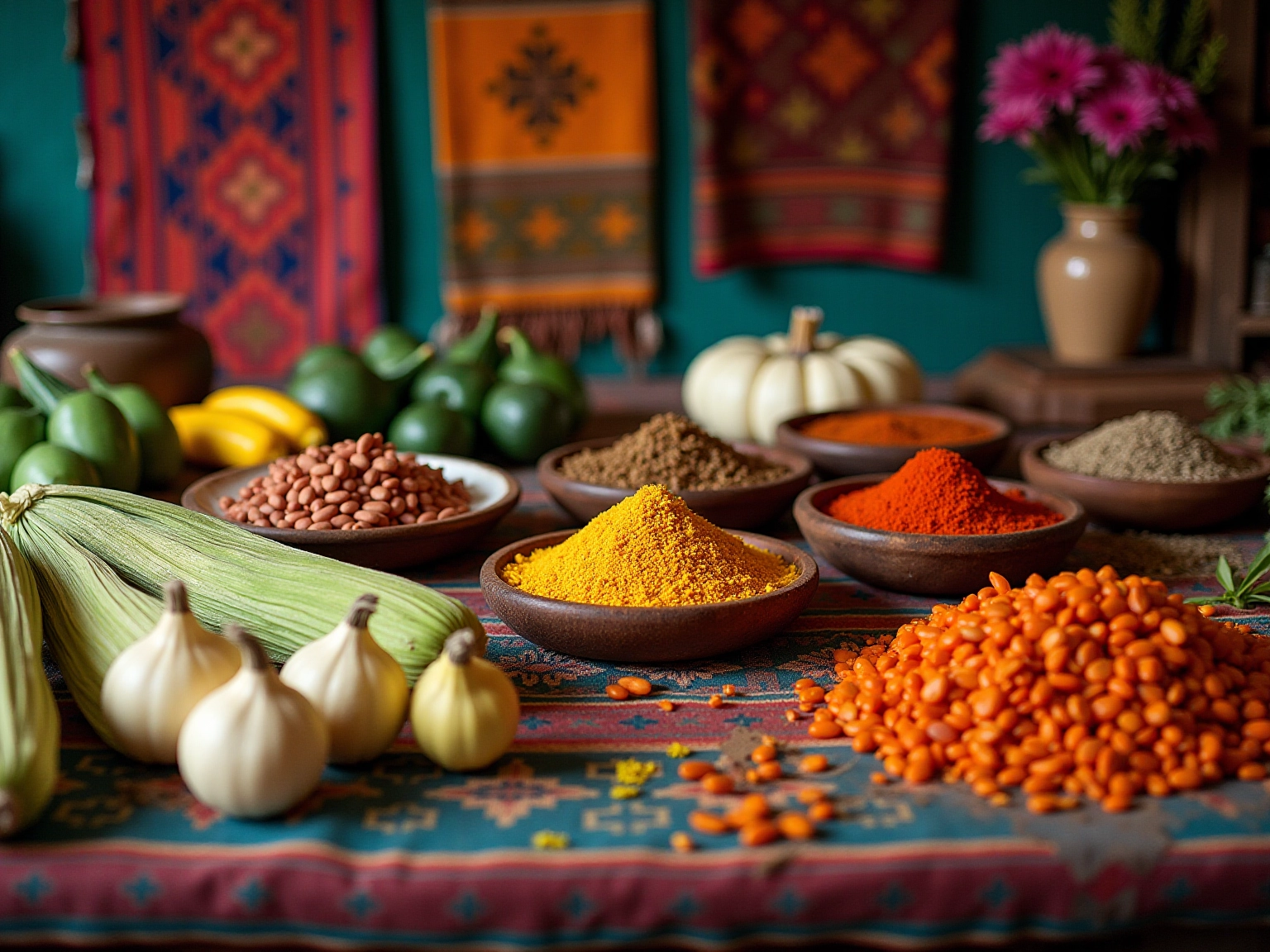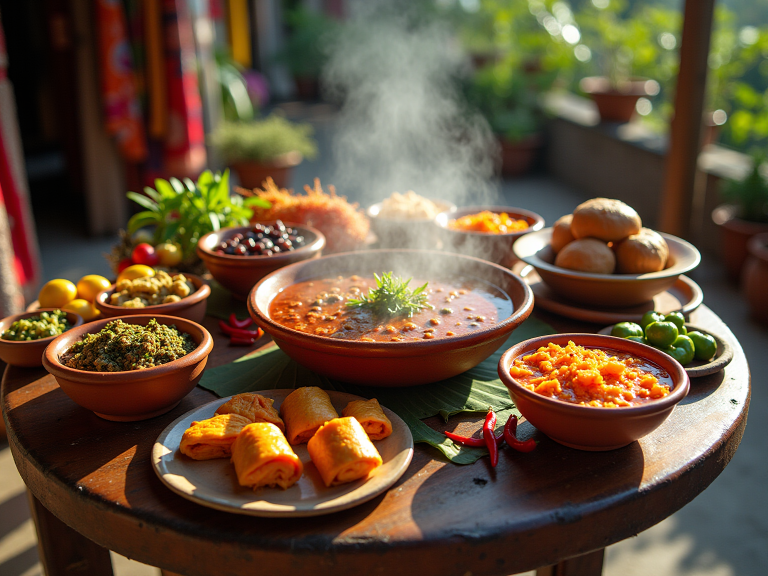Overview
Guatemalan food is a delightful tapestry woven from indigenous Mayan traditions and Spanish colonial influences. At the heart of this culinary adventure are staple ingredients like corn, beans, and chilies. Imagine savoring signature dishes such as Pepián and Kak’ik—each bite tells a story of rich history and vibrant culture!
But it’s not just about the flavors; this article also dives into the challenges, like food insecurity, that impact the culinary landscape. These elements shape not only the resilience of Guatemalan cuisine but also its cultural significance. So, as you explore this delicious world, you’ll discover how food connects to the very soul of Guatemala!
Key Highlights:
- Guatemalan cuisine is a fusion of indigenous Mayan traditions and Spanish colonial influences.
- Staple ingredients such as corn, beans, and chilies are central to Guatemalan food culture.
- Spanish colonization introduced new ingredients and techniques, enriching the culinary landscape.
- Regional variations in cooking reflect local traditions and ingredients, creating distinct flavors.
- Signature dishes include Pepián (meat stew), Kak’ik (turkey soup), Tamales (corn dough filled with meats), and Chiles Rellenos (stuffed peppers).
- Food insecurity poses challenges, with only a small percentage of low-income farmers accessing support programs.
- Culinary practices serve as a means of cultural preservation and community resilience in Guatemala.
- Innovative dining experiences celebrate traditional ingredients, such as corn at Casa Cristal Bistro.
- Local cooking techniques, like open-fire cooking and using a comal, enhance the authenticity of dishes.
- Festivals in Guatemala showcase traditional dishes, reflecting community spirit and cultural heritage.
Introduction
In the heart of Central America lies Guatemala, a country where the culinary landscape is as diverse and vibrant as its rich cultural heritage! Guatemalan cuisine is a fascinating blend of ancient Mayan traditions and Spanish colonial influences, creating a unique tapestry of flavors that tells the story of its people. From robust stews and traditional tamales to fresh ingredients sourced from local markets, each dish reflects a deep connection to the land and its history.
As we navigate the challenges of food insecurity, understanding the complexities of this culinary art form becomes essential. It reveals not only the resilience of its traditions but also the innovative spirit that continues to shape its future. This exploration of Guatemalan cuisine invites you to savor the stories behind each bite, celebrating a culture that thrives on the interplay of past and present!
Understanding Guatemalan Cuisine: A Cultural Mosaic
Famous Guatemalan food is like a vibrant tapestry, woven from the rich threads of its cultural heritage. It showcases a unique food identity that springs from the fusion of indigenous Mayan traditions and Spanish colonial influences, which is reflected in famous Guatemalan food. At the heart of this food landscape, famous Guatemalan food is made from staple ingredients such as corn, beans, and chilies, which are deeply rooted in Mayan culture. You’ll find that the importance of these indigenous ingredients is echoed by cooking experts who highlight their role in shaping the region’s flavors and dishes. Chef José Andrés captures this beautifully when he says, “The modernity of yesterday is the tradition of today, and the modernity of today will be tradition tomorrow.” This really emphasizes how cooking practices evolve over time!
But wait, there’s more! The Spanish colonization introduced new ingredients and cooking techniques, enriching the gastronomic landscape even further. This blend of influences isn’t just a thing of the past; it continues to shape contemporary Guatemalan cuisine, including its famous Guatemalan food. Just look at innovative dining experiences like La Experiencia Maiz at Casa Cristal Bistro, which celebrates corn—one of Guatemala’s superfoods—through a delightful tea time-inspired tasting menu.
However, it’s essential to acknowledge that the food landscape faces significant challenges, such as food insecurity. Currently, only 7,357 low-income Guatemalans have accessed the Agricultural Stipend program out of 180,000 farmers. This statistic highlights the structural issues that impact food access. And let’s not forget about regional variations! They add another layer to this social mosaic, where local ingredients and traditions create distinct flavors and dishes across the country. By blending qualitative and quantitative data in research on food security, we uncover the complexities of cooking practices and their connections to cultural heritage.
Understanding this context is crucial for appreciating the depth and diversity of famous Guatemalan food. It reflects an ongoing dialogue between past and present, tradition and innovation. Plus, food insecurity is a self-replicating structural phenomenon linked to poor educational attainment, which underscores the challenges faced by the culinary community in Guatemala. Isn’t it fascinating how food connects us all, even amidst challenges?

Historical Influences on Guatemalan Food: From Maya to Modernity
The evolution of the country’s cuisine includes famous Guatemalan food and is a rich tapestry woven from centuries of cultural influences. At its core, the ancient Maya civilization established foundational agricultural practices, cultivating essential crops like maize, beans, and squash—ingredients that still play a vital role in today’s diets of the region. When the Spanish colonizers arrived in the 16th century, they brought a pivotal shift, introducing new ingredients like rice, pork, and a variety of spices. This blend of indigenous and European flavors transformed traditional cooking methods and broadened the food repertoire, contributing to what is now known as famous Guatemalan food, which continued to diversify over time by incorporating African and Caribbean influences that enhanced the flavors and techniques used in local dishes.
Interestingly, San Juan La Laguna has emerged as a key place for obtaining handwoven textiles, showcasing the artistic skills that enrich the famous Guatemalan food. This historical journey—from the agricultural advancements of the Maya to the contemporary adaptations we observe today—illustrates how famous Guatemalan food has developed while keeping its traditional essence intact. Alfred Jensen, a painter and printmaker born in Guatemala, once remarked that the famous Guatemalan food culture plays a vital role in the country’s identity. The interplay of these diverse influences not only reflects the country’s history but also highlights the resilience and creativity of its famous Guatemalan food traditions.
If you’re planning a trip, the best time to visit Guatemala is during the dry season, from November to April, when the weather is just right for exploring its famous Guatemalan food and rich gastronomic offerings. Plus, initiatives aimed at empowering children in Guatemala highlight the broader social framework in which this food culture exists, showing how cooking traditions serve as a means of cultural preservation and community resilience.

Signature Dishes of Guatemala: A Culinary Tour
The food scene in Guatemala is bursting with famous Guatemalan food specialties that reflect its lively heritage! One standout dish is Pepián, a robust meat stew that offers a complex blend of spices and vegetables, usually served alongside rice. This meal not only delights your taste buds but also tells the story of the historical influences that have shaped famous Guatemalan food. Another must-try is Kak’ik, a traditional turkey soup infused with coriander and spices, showcasing the indigenous roots of the country’s culinary practices.
You can’t visit Guatemala without trying Tamales! These beloved staples consist of corn dough filled with various meats or vegetables, wrapped in banana leaves, and steamed to perfection. They’re often enjoyed during festive occasions, symbolizing community and tradition. And let’s not forget Chiles Rellenos, or stuffed peppers, which highlight the local chilies and are a testament to the region’s agricultural bounty.
The cultural significance of famous Guatemalan food is truly remarkable. For example, Pepián is often celebrated as a national dish, renowned for its depth of flavor and historical roots. Chef Pablo Diaz, who is known for his innovative approach at Mercado 24, emphasizes the importance of local ingredients. He cleverly incorporates Asian flavors while honoring traditional recipes, enhancing the dining experience and paying homage to Guatemala’s diverse culinary heritage.
Take a look at Los Shucos del Liceo—they started as hot dog carts and have now evolved into a renowned restaurant! Their unique take on hot dogs has attracted a varied clientele, showcasing the flexibility and inventiveness inherent in Guatemalan cuisine.
And let’s not overlook Atol, a creamy drink made primarily from sweet corn. It’s often sold by street vendors and enjoyed as a quick breakfast or snack by workers. This highlights the intersection of convenience and tradition in local food culture.
The story of Hugos Ceviche Restaurante is also a gem! It began serving ceviches in 1993 from a red pickup truck and has since become a beloved spot for both locals and tourists, showcasing the vibrant flavors of ceviche.
In the realm of beverages, Bill Esparza notes, “This is also the home of the perfect picosito, the legendary Guatemalan beer cocktail prepared in a can of Gallo beer with Worcestershire, fresh squeezed lime, salt, and picante.” This adds a unique perspective on the local drink culture, complementing the culinary landscape beautifully.
In summary, each famous Guatemalan food not only excites your palate but also narrates a story of the region’s rich history and identity. So, why not dive in and savor the genuine flavors of this Central American gem? You won’t regret it!
Local Ingredients and Cooking Techniques: The Heart of Guatemalan Flavors
When you think of famous Guatemalan food, envision the vibrant local ingredients that are at its heart—especially corn, beans, chilies, and a colorful array of fresh vegetables and herbs. Corn isn’t just a dietary staple; it’s a cultural icon, appearing in famous Guatemalan food such as tortillas and tamales. The food scene is truly enriched by fresh, locally sourced ingredients, often cooked using time-honored techniques like open-fire cooking or on a comal, a flat griddle that’s essential for crafting those perfect tortillas. These methods enhance the flavors and textures of the meals, all while preserving the authenticity of Guatemalan cooking traditions.
But it goes beyond just cooking! Focusing on local sourcing not only supports sustainable agriculture but also deepens the community’s ties to its rich culinary heritage. Just think about the lively fiestas in Guatemala—these festivals are a fantastic showcase of this connection, where famous Guatemalan food takes center stage in cultural expression, celebrating community spirit through a delightful range of traditional dishes. And you can really feel this engagement during the festivals, where specific traditional dishes are celebrated, reflecting the nation’s heritage and that wonderful sense of community. So, are you ready to dive into this delicious adventure?
Conclusion
Guatemalan cuisine is truly a delightful journey through the country’s rich cultural tapestry, woven from ancient Mayan traditions and Spanish colonial influences. When you dive into signature dishes like Pepián, Kak’ik, and tamales, you not only experience the unique flavors of Guatemala but also catch glimpses of the historical and cultural stories that shape this vibrant nation. Each dish has its own tale, showcasing the resilience and creativity of its people over centuries of evolution and adaptation.
Don’t overlook the importance of local ingredients like corn, beans, and chilies! These staples form the backbone of Guatemalan cooking and reflect the region’s deep agricultural roots. The cooking techniques passed down through generations enhance these ingredients’ flavors, ensuring that traditional practices endure even as modern influences come into play. This dynamic blend of tradition and innovation creates a culinary landscape that’s not just rich but also alive and thriving today.
Yet, amidst this culinary richness, food insecurity poses a significant challenge, highlighting the need to address structural issues affecting food access. Understanding these complexities is key to appreciating not just the depth of Guatemalan cuisine but also the ongoing dialogue between its past and present. By cherishing these culinary traditions, there’s hope for a sustainable future that honors Guatemala’s diverse cultural heritage while empowering its communities. So, as you savor the flavors of this Central American gem, you’re truly engaging with the stories, struggles, and triumphs of its people, ensuring that the essence of Guatemalan cuisine lives on for generations to come.
Frequently Asked Questions
What defines famous Guatemalan food?
Famous Guatemalan food is defined by a unique food identity that combines indigenous Mayan traditions with Spanish colonial influences, featuring staple ingredients such as corn, beans, and chilies.
How do indigenous ingredients influence Guatemalan cuisine?
Indigenous ingredients like corn, beans, and chilies are deeply rooted in Mayan culture and are essential in shaping the flavors and dishes of Guatemalan cuisine, as highlighted by cooking experts.
What role does Spanish colonization play in Guatemalan food?
Spanish colonization introduced new ingredients and cooking techniques, enriching the gastronomic landscape of Guatemala and continuing to influence contemporary cuisine.
Can you give an example of a modern dining experience that highlights Guatemalan food?
An example is La Experiencia Maiz at Casa Cristal Bistro, which celebrates corn, a key ingredient in Guatemalan cuisine, through a tea time-inspired tasting menu.
What challenges does the Guatemalan food landscape face?
The Guatemalan food landscape faces challenges such as food insecurity, with only a small fraction of low-income farmers accessing support programs, highlighting structural issues affecting food access.
How do regional variations impact Guatemalan cuisine?
Regional variations contribute to distinct flavors and dishes across Guatemala, as local ingredients and traditions create a diverse culinary landscape.
Why is understanding the context of Guatemalan food important?
Understanding the context is crucial for appreciating the depth and diversity of Guatemalan food, as it reflects an ongoing dialogue between tradition and innovation, while also addressing issues like food insecurity and educational challenges.


































